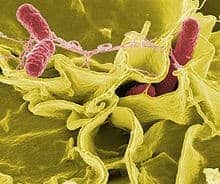A surprising result in an experiment on Salmonella bacteria has led to a discovery that may make drug-resistant cancer cells more treatable by conventional chemotherapies. Scientists at UMass Medical School have found that the Salmonella protein SipA naturally reduces a well-known drug-resistant molecule found in many different types of cancer cells. By delivering the protein attached to tiny gold nanoparticles, researchers were able to dramatically boost tumor sensitivity to chemotherapeutic drugs and shrink colon and breast cancer tumors in mice.
“It is fascinating to think that this discovery has incredible clinical potential for treating certain drug resistant cancers. On the strength of these findings, we’re already moving into pre-clinical development,” said Beth A. McCormick, PhD, vice chair and professor of microbiology & physiological systems and a lead author of the study in Nature Communications.
Scientists have observed for more than 150 years that various types of bacteria can reduce cancer tumors. More recently, investigators have proposed using bacteria, such as Salmonella, to indirectly stimulate immune reactions that can fight cancer cells. It has also been found that some bacteria can selectively grow in tumors, suggesting additional therapeutic potential. Despite these observations, the mechanisms controlling these various effects have remained elusive. And attempts to use Salmonella or other bacteria therapeutically have proven unsuccessful for reasons associated with immune-related responses and concerns about potential infection.
Dr. McCormick, who is an expert in infectious disease and director of the UMass Center for Microbiome Research, was investigating the biological tools Salmonella uses to overcome a cell’s innate defenses in order to infect them. Specifically, she was looking at the impact that SipA (Salmonella invasion protein A) has on certain transport proteins found in human intestine cells. Believing that SipA may be upregulating one of these proteins to induce an inflammatory response, she ran a series of experiments using a common transport protein, P-gp, as her control. Not expecting to find anything out of the ordinary, she instead made the startling discovery that the bacterial product had almost completely wiped out the P-gp transporter protein.
Found on the cell surface, P-gp is normally responsible for waste removal, pumping foreign matter, debris and toxins out of the cell. For this reason, McCormick believes the Salmonella bacterium wants to disable the P-gp protein so it can more easily infect cells. In cases of cancer recurrence, an overabundance of P-gp in tumor cells can lead to the development of drug resistance. In these cells, P-gp works to pump chemotherapy and anticancer drugs out of the cells before they can build up and kill them.
McCormick knew how important P-gp was to drug resistance in cancer. This new evidence suggested that SipA alone could knock out the P-gp protein responsible for multi-drug resistant cancer.
Despite SipA’s potential to be used as a cancer therapy, the protein still had to be delivered to the tumor in vivo. McCormick enlisted the collaboration of Gang Han, PhD, associate professor of biochemistry & molecular pharmacology and an expert in nanomedicine, to develop a Salmonellananoparticle mimic to carry SipA.
“Outside of the bacteria, the SipA protein was too unstable to simply inject into a potential patient,” said Dr. Han, also a lead author of the study. “Rather than using the whole bacteria, we developed a nanoparticle scaffold to mimic the bacteria and stabilize and deliver the protein. We refer to this particle as a ‘nanobug.’”
Selecting gold because of its inert nature and unique three-dimensional scaffold, Han developed a nanoparticle small enough to infiltrate the tumor but large enough to not be absorbed by most biological tissues. “Tumors are different than normal tissues,” said Regino Mercado-Lubo, MD, a postdoctoral fellow in the McCormick lab and first author of the study. “They tend to be leaky. So the hope was that our nanobug could penetrate tumors without accumulating in other tissues.”
Researchers deployed the SipA-nanobug, along with the widely used chemotherapy drug Doxorubicin, into a mouse model with colon cancer and a humanized mouse model with breast cancer. “The results were astonishing,” said Dr. Mercado-Lubo. “After 30 days the tumors were almost undetectable. It was remarkable. In some cases the tumors became little more than thin slices of tissue.”
Just as importantly, according to Mercado-Lubo, there was no buildup of the gold nanoparticle in lung, cardiac or brain tissues.
The next step for McCormick, Han and colleagues, is to move the research into pre-clinical development. This will help determine safety, toxicity and dosage levels for moving the nanobug into patient trials.
“For almost two decades, scientists have looked to reverse drug resistance in cancer cells by screening thousands of small molecules looking for something to inhibit P-gp,” said McCormick. “These attempts have failed to translate to the clinic. With SipA we have the precedence of nature and 2 million years of co-evolution that suggests it can effectively remove P-gp from cells and without inducing an immune response.”
“The bacterial nanoparticle mimic we’ve developed has the potential to stabilize therapeutic proteins and to be used in conjunction with a wide variety of clinically used chemotherapeutic drugs to overcome multidrug resistance in a variety of tumors.” Han added.


